Optical and SPION-enhanced MR imaging shows that trans-stilbene inhibitors of NF-κB concomitantly lower Alzheimer's disease plaque formation and microglial activation in AβPP/PS-1 transgenic mouse brain
- PMID: 24413613
- PMCID: PMC4407807
- DOI: 10.3233/JAD-131031
Optical and SPION-enhanced MR imaging shows that trans-stilbene inhibitors of NF-κB concomitantly lower Alzheimer's disease plaque formation and microglial activation in AβPP/PS-1 transgenic mouse brain
Abstract
Alzheimer's disease (AD) is associated with a microglia-dependent neuroinflammatory response against plaques containing the fibrous protein amyloid-β (Aβ). Activation of microglia, which closely associate with Aβ plaques, engenders the release of pro-inflammatory cytokines and the internalization of Aβ fibrils. Since the pro-inflammatory transcription factor NF-κB is one of the major regulators of Aβ-induced inflammation, we treated transgenic amyloid-β protein protein/presenilin-1 (AβPP/PS1) mice for one year with a low dose (0.01% by weight in the diet) of either of two trans-stilbene NF-κB inhibitors, resveratrol or a synthetic analog LD55. The 3D distribution of Aβ plaques was measured ex vivo in intact brains at 60 μm resolution by quantitative magnetic resonance imaging (MRI) using blood-brain barrier-permeable, anti-AβPP-conjugated superparamagentic iron oxide nanoparticles (SPIONs). The MRI measurements were confirmed by optical microscopy of thioflavin-stained brain tissue sections and indicated that supplementation with either of the two trans-stilbenes lowered Aβ plaque density in the cortex, caudoputamen, and hippocampus by 1.4 to 2-fold. The optical measurements also included the hippocampus and indicated that resveratrol and LD55 reduced average Aβ plaque density by 2.3-fold and 3.1-fold, respectively. Ex vivo measurements of the regional distribution of microglial activation by Iba-1 immunofluorescence of brain tissue sections showed that resveratrol and LD55 reduced average microglial activation by 4.2- fold and 3.5-fold, respectively. Since LD55 lacked hydroxyl groups but both resveratrol and LD55 concomitantly reduced both Aβ plaque burden and neuroinflammation to a similar extent, it appears that the antioxidant potential of resveratrol is not an important factor in plaque reduction.
Keywords: LD55; NF-κB; SPIONs; magnetic resonance imaging; microglia; neuroinflammation; resveratrol; transgenic mice.
Figures
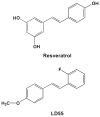
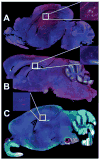
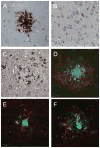


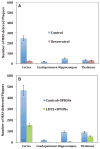
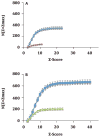

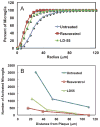
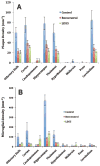

Similar articles
-
Resveratrol mitigates lipopolysaccharide- and Aβ-mediated microglial inflammation by inhibiting the TLR4/NF-κB/STAT signaling cascade.J Neurochem. 2012 Feb;120(3):461-72. doi: 10.1111/j.1471-4159.2011.07594.x. Epub 2011 Dec 16. J Neurochem. 2012. PMID: 22118570 Free PMC article.
-
Superparamagnetic nanoparticle-enhanced MRI of Alzheimer's disease plaques and activated microglia in 3X transgenic mouse brains: Contrast optimization.J Magn Reson Imaging. 2017 Aug;46(2):574-588. doi: 10.1002/jmri.25563. Epub 2016 Nov 22. J Magn Reson Imaging. 2017. PMID: 27875002
-
SPION-enhanced magnetic resonance imaging of Alzheimer's disease plaques in AβPP/PS-1 transgenic mouse brain.J Alzheimers Dis. 2013;34(2):349-65. doi: 10.3233/JAD-121171. J Alzheimers Dis. 2013. PMID: 23229079 Free PMC article.
-
Microglia and amyloid plaque formation in Alzheimer's disease - Evidence, possible mechanisms, and future challenges.J Neuroimmunol. 2024 May 15;390:578342. doi: 10.1016/j.jneuroim.2024.578342. Epub 2024 Apr 4. J Neuroimmunol. 2024. PMID: 38640827 Review.
-
Therapeutic potential of plant-derived natural compounds in Alzheimer's disease: Targeting microglia-mediated neuroinflammation.Biomed Pharmacother. 2024 Sep;178:117235. doi: 10.1016/j.biopha.2024.117235. Epub 2024 Aug 1. Biomed Pharmacother. 2024. PMID: 39094545 Review.
Cited by
-
Comparisons of neuroinflammation, microglial activation, and degeneration of the locus coeruleus-norepinephrine system in APP/PS1 and aging mice.J Neuroinflammation. 2021 Jan 6;18(1):10. doi: 10.1186/s12974-020-02054-2. J Neuroinflammation. 2021. PMID: 33407625 Free PMC article.
-
Polyphenols Targeting NF-κB Pathway in Neurological Disorders: What We Know So Far?Int J Biol Sci. 2024 Jan 27;20(4):1332-1355. doi: 10.7150/ijbs.90982. eCollection 2024. Int J Biol Sci. 2024. PMID: 38385077 Free PMC article. Review.
-
Natural product-based amyloid inhibitors.Biochem Pharmacol. 2017 Sep 1;139:40-55. doi: 10.1016/j.bcp.2017.04.004. Epub 2017 Apr 6. Biochem Pharmacol. 2017. PMID: 28390938 Free PMC article. Review.
-
Sex-Specific Adaptations in Alzheimer's Disease and Ischemic Stroke: A Longitudinal Study in Male and Female APPswe/PS1dE9 Mice.Life (Basel). 2025 Feb 21;15(3):333. doi: 10.3390/life15030333. Life (Basel). 2025. PMID: 40141679 Free PMC article.
-
An Overview of the Nrf2/ARE Pathway and Its Role in Neurodegenerative Diseases.Int J Mol Sci. 2021 Sep 4;22(17):9592. doi: 10.3390/ijms22179592. Int J Mol Sci. 2021. PMID: 34502501 Free PMC article. Review.
References
-
- Alzheimer’s Association. Alzheimer’s disease facts and figures. Alzheimer’s Association; Washington, D.C: 2011. http://www.alz.org/downloads/facts_figures_2011.pdf. - PubMed
-
- Hebert LE, Scherr PA, Bienias JL, Bennett DA, Evans DA. Alzheimer’s disease in the U.S. population: Prevalence estimates using the 2000 census. Arch Neurol. 2003;60:1119–1122. - PubMed
-
- Fodero-Tavoletti AT, Villemagn VL, Rowe CC, Masters CL, Barnham KJ, Cappai R. Amyloid-β: The seeds of darkness. Int J Biochem Cell Biol. 2011;43:1247–1251. - PubMed
-
- McLean CA, Cherny RA, Fraser FW, Fuller SJ, Smith MJ, Beyreuther K, Bush AI, Masters CL. Soluble pool of Abeta amyloid as a determinant of severity of neurodegeneration in Alzheimer’s disease. Ann Neurol. 1999;46:860–866. - PubMed
Publication types
MeSH terms
Substances
Grants and funding
LinkOut - more resources
Full Text Sources
Other Literature Sources
Medical
Molecular Biology Databases

